| Look up scull in Wiktionary, the free dictionary. |
Scull may refer to:
| Look up scull in Wiktionary, the free dictionary. |
Scull may refer to:

Rowing, sometimes called crew in the United States, is the sport of racing boats using oars. It differs from paddling sports in that rowing oars are attached to the boat using oarlocks, while paddles are not connected to the boat. Rowing is divided into two disciplines: sculling and sweep rowing. In sculling, each rower holds two oars—one in each hand, while in sweep rowing each rower holds one oar with both hands. There are several boat classes in which athletes may compete, ranging from single sculls, occupied by one person, to shells with eight rowers and a coxswain, called eights. There are a wide variety of course types and formats of racing, but most elite and championship level racing is conducted on calm water courses 2 kilometres (1.2 mi) long with several lanes marked using buoys.
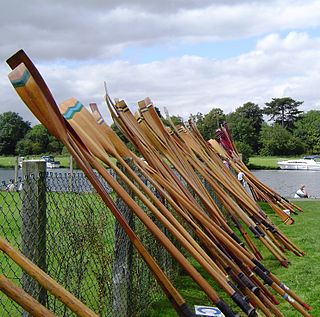
An oar is an implement used for water-borne propulsion. Oars have a flat blade at one end. Rowers grasp the oar at the other end.
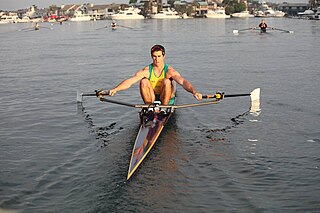
Sculling is the use of oars to propel a boat by moving the oars through the water on both sides of the craft, or moving a single oar over the stern. A long, narrow boat with sliding seats and rigged with two oars per rower may be referred to as a scull, its oars may be referred to as sculls, and a person rowing it referred to as sculler.

Rowing is the act of propelling a boat using the motion of oars in the water by displacing water to propel the boat forward. Rowing and paddling are similar. However, rowing requires oars to have a mechanical connection with the boat, while paddles are hand-held and have no mechanical connection.
In watercraft, a racing shell is an extremely narrow, and often comparatively long, rowing boat specifically designed for racing or exercise. It is outfitted with long oars, outriggers to hold the oarlocks away from the boat, and sliding seats. The boat's long length and semicircular cross-section reduce drag to a minimum. This makes the boat both fast and unstable. It must be balanced by the rowers to avoid tipping. Being able to balance – or "set" – the boat while putting maximum effort into the oars is therefore an essential skill of sport rowing.
In competitive rowing, the following specialized terms are important in the corresponding aspects of the sport:
In rowing, the stroke is the action of moving the oar through the water in order to propel the boat forward. The two fundamental reference points in the stroke are the catch where the oar blade is placed in the water, and the extraction where the oar blade is removed from the water. After the blade is placed in the water at the catch, the rower applies pressure to the oar levering the boat forward which is called the drive phase of the stroke. Once the rower extracts the oar from the water, the recovery phase begins, setting up the rower's body for the next stroke.

A single scull is a rowing boat designed for a single person who propels the boat with two oars, one in each hand.
Women's quadruple sculls competition at the 2008 Summer Olympics in Beijing was held between August 10 and 17, at the Shunyi Olympic Rowing-Canoeing Park.

A double scull is a rowing boat used in the sport of competitive rowing. It is designed for two persons who propel the boat by sculling with two oars each, one in each hand.

A quadruple sculling boat, often simply called a quad and abbreviated 4x, is a rowing boat used in the sport of competitive rowing. It is designed for four persons who propel the boat by sculling with two oars, or "sculls", one in each hand.
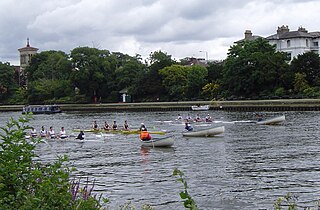
A coxed four is a rowing boat used in the sport of competitive rowing. It is designed for four persons who propel the boat with sweep oars and is steered by a coxswain.
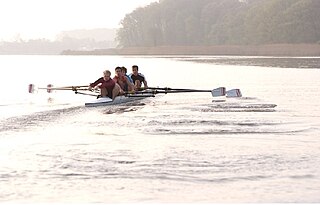
A coxless four is a rowing boat used in the sport of competitive rowing. It is designed for four persons who propel the boat with sweep oars, without a coxswain.
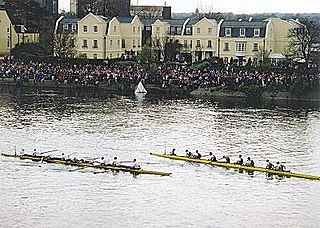
An eight is a rowing boat used in the sport of competitive rowing (crew). It is designed for eight rowers, who propel the boat with sweep oars, and is steered by a coxswain, or "cox".

Human-powered watercraft are watercraft propelled by human power.
The women's single sculls competition at the 2002 Asian Games in Busan was held from 30 September to 2 October at the Nakdong River.

The men's quadruple sculls event at the 2020 Summer Olympics took place from 23 to 28 July 2021 at the Sea Forest Waterway. 40 rowers from 10 nations competed.

The women's double sculls event at the 2020 Summer Olympics is scheduled took place from 23 to 28 July 2021 at the Sea Forest Waterway. 26 rowers from 13 nations competed.

The women's quadruple sculls event at the 2020 Summer Olympics took place from 23 to 28 July 2021 at the Sea Forest Waterway. 40 rowers from 10 nations competed.

Stern sculling is the use of a single oar over the stern of a boat to propel it with side-to-side motions that create forward lift in the water. It is distinguished from sculling, which is rowing with two oars on either side of the boat and from sweep rowing, whereby each boat crew member employs a single oar, complemented by another crew member on the opposite side with an oar, usually with each pulling an oar with two hands.